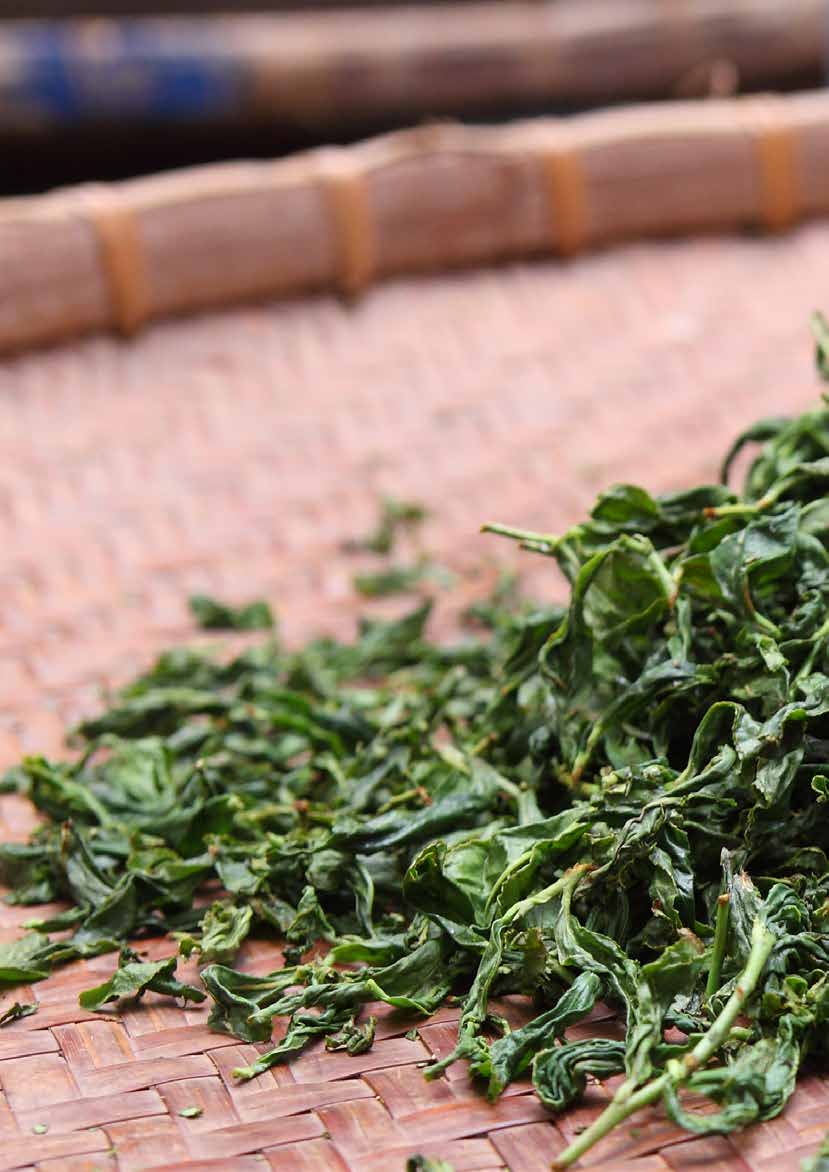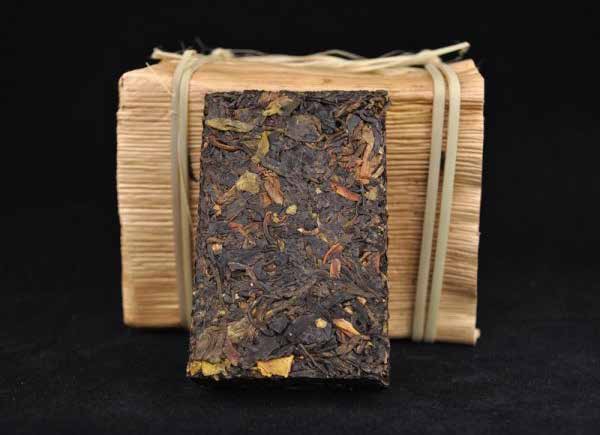
 |
|
As we walk the trail, rounding corners and crossing streams, the quiet of the jungle slowly rises past the sounds of the birds and wind, past the distant monkeys to slowly steep your heart in its calm. The stillness envelops all the natural sounds, deepening rather than interrupting the quiet. A few hours further on and you begin to feel as if you're as much a part of it all as the insects, as the stillness. I point out a tea garden to you, but you can't help exclaiming, "Where?" We walk off the path and into the trees, surrounded by underbrush, leaves, loam and flowers. For the first time you realize that Living Tea is the forest, rather than just growing in it. You can't even see where the tea garden begins and the jungle ends; it looks like all the other views we've seen on our hike here - stream and hill, tree and flower. You understand more about the medicine of Tea, connecting the human to Tea, and through it to the whole forest it is not just a part of, but an embodiment of. The small plants' energy is eaten by bugs, which are taken by snakes and then excreted. Meters deep, the soil is digesting and churning minerals and fungi. Microbes cover the tea trees and moss grows on the trunks. The sun and moon, water and minerals are all living so vibrantly here. And everything thrums with the life of it all. "Tea is our contact point to communicate with this," you say scooping up a handful of loamy soil and smiling at me. I agree, we are as much the Earth as that...

In past issues, we have discussed what Living Tea is and why it has such healing potential. We talked about the four characteristics of Living Tea: Seed-propagated, room to grow, biodiversity and a healthy relationship to the humans who tend it. This month's tea is definitely a Living Tea, and through it we can discuss some of these issues more deeply.
Tea is a sexual plant, which means that it is cross-pollinated. A tremendous amount of natural energy goes into the creation of a Tea seed, including bugs and forest, sun and sky. Each one carries great energy within it. And no two Tea seeds are alike. They will each produce a completely unique Tea tree, which is why Tea has done so well traveling to different climates. If you plant a thousand seeds, the chances that one of them will survive are high. Unfortunately, very little Tea in the world is seed-propagated. The reason, of course, is industry and the commoditization of Tea. Sadly, Tea faces many of the problems that all agricultural products are haunted by. Most Tea plantations use cuttings from a tree, planted to produce another. They are in essence clones. They do this to achieve a uniformity of flavor. Also, with a few hundred, or even thousands of different trees, all with different needs, the farmer would potentially have a lot more work to do.

It took millennia for trees like Tea to develop sexual cross-fertilization. It is also tremendously difficult for such trees to fertilize one another, since the mates cannot move towards embrace the way that animals and people can. As a result, plants have developed magnificent ways of fertilizing each other, enticing insects to pollinate them, using the wind, etc. There is a reason for all this. Carl Sagan said that the evolution from asexual to sexual reproduction on this planet was as significant as the beginning of life itself, as it allows for all the creative power in Nature to assert itself in such myriad forms. There is something deep and powerful missing when a plant is not allowed to cross-fertilize. The variety in Nature is magic, just as in humans. Every tree is then different. Sure, they share some similarities due to common genetic heritage and similar terroir (climate, soil, etc.), but like people they each have their own medicine, their own perspective, experience and wisdom.
The difference in power and healing between seed-propagated and cloned Tea is obvious. There are essentially two main varieties of Tea trees: what are called "Big Leaf Trees", which are the original, oldest Tea trees (which we're drinking this month). They have a single trunk, grow very tall and have roots that go straight down. As Tea moved north it evolved into "Small Leaf Trees", which are more bush-like. They have many trunks and roots that grow outwards. In fact, the leaves got smaller and smaller as Tea moved north, whether naturally or carried by man, until you get to Japan where the leaves are so small they look like needles after they're rolled. Big Leaf Tea trees can live thousands of years. The oldest one we've dated is 3,500 years old! It is about seven people around (I kissed it, and once for you). There are probably older ones out there, or at least were in the past. Small Leaf Tea Trees can live hundreds of years, and some are many centuries old. Here's the punch line: The clones on plantations typically live thirty to fifty years only. And more than a few farmers have told me that they aren't living as long anymore, sometimes as few as fifteen to twenty years.
There are several species of birds that love to eat Tea seeds. They are rich and oily and full of nutrients. Farmers make cooking oil out of them. It's delicious. Anyway, more than one farmer has told me that after the second generation of cloning, the birds will no longer eat the Tea seeds anymore.
Nature has been creating life for millennia, so it is very unhealthy for us to assume that we can improve or alter her designs. Our attempts to interfere with Nature rarely take into account all the biodiversity and infinite, immeasurable connections there are between species. We take control of an environment and monocrop it, controlling a few factors in a huge web of symmetry. As we've done this to larger and more diverse areas, our meddling has begun to have a global impact, changing the Environment (capital 'E') rather than just the places where we farm.
Actually, none of our creations ever come close to the power or beauty of Nature, especially since we too are one of her greater masterpieces - so all that we create also owes homage to Mother Earth, ultimately. Allowing her creative license is an important aspect of the diversity of life that sustains this planet, and any given environment. When tea is natural, and seed-propagated, every single tree is unique. Mutations arise. They each have a place and a hue, and in that way she can create more and varied medicine for us. It is presumptuous to assume that all the variety in tea is man made, and has to do exclusively with processing, as some authors would suggest. A tremendous amount of variety is natural-born, and defies our limited categories.

This month's tea is one such tea. It is an incredibly fantastic raw Puerh made from wild tree leaves that have a dark purple color. This varietal is called "Camellia sinensis (L.) Kuntze var. Assamica Kitam". It is primeval and actually pre-dates Camellia Sinensis var. Assamica. It is a naturally occurring non-hybridized varietal. Its potency in Cha Qi arises from its unadulterated Nature. It is naturally bug repellent, and grows wild in the forests of Yunnan at an altitude of 1600-2200 meters.
That it predates the varietal of Camellia that we normally assume to be "Tea" raises interesting questions about what it even means to say that something is tea. The categories we use to separate these varietals are, of course, arbitrary. Still, this lineage of trees is unique enough that it is considered by biologists to be a separate varietal altogether. Curiously, it is an older cousin of the modern tea tree, but with all the force and power we love. This suggests that the lines between what this medicinal herb actually is and when it began aren't as clear as we've thought. Recently, several new varietals have been discovered and named, some of which are - like this month's tea - a rediscovery of something older than our modern tea trees.
This confuses things a bit, as perhaps they should be. On the external level, I wouldn't say that any herb infused in water is "Tea", but on a deeper level, the fact that many of the varietals of Camellia sinensis are medicinal, and barely distinguishable reminds us that the forest is Tea and Tea is the forest. The boundaries we draw are merely semantic, used to communicate categories and concepts, and have no place in the real world - where life and energy moves throughout all species, and from the so-called "inorganic" to the "organic". The sun and moon, rocks and waters flow powerfully through these tea leaves.
The infused liquor is bright and is almost completely without bitterness. There is a strong full taste and a warm stimulating feel in the mouth and body after drinking this tea. It is composed of spring 2013 raw material from the north-western area of Dehong County, Yunnan. This is the forest where the Purple-bud Red Tea we sent earlier this year also came from. This older cousin is wilder, stronger and more vibrant.

Try drinking this tea in the afternoon or early morning. Let it infuse you with the depth and power of a hike through the jungle from whence it came. It will open your day to new possibilities, and allow you to appreciate more of the amazing connections you already have with the Sky and Earth, as well as the people around you. We find this tea to be very healing, attuning us spiritually to the natural rhythms, which start to make sense after a few bowls of this delicious tea - the last of the Sheng Puerhs we will drink together this year...
